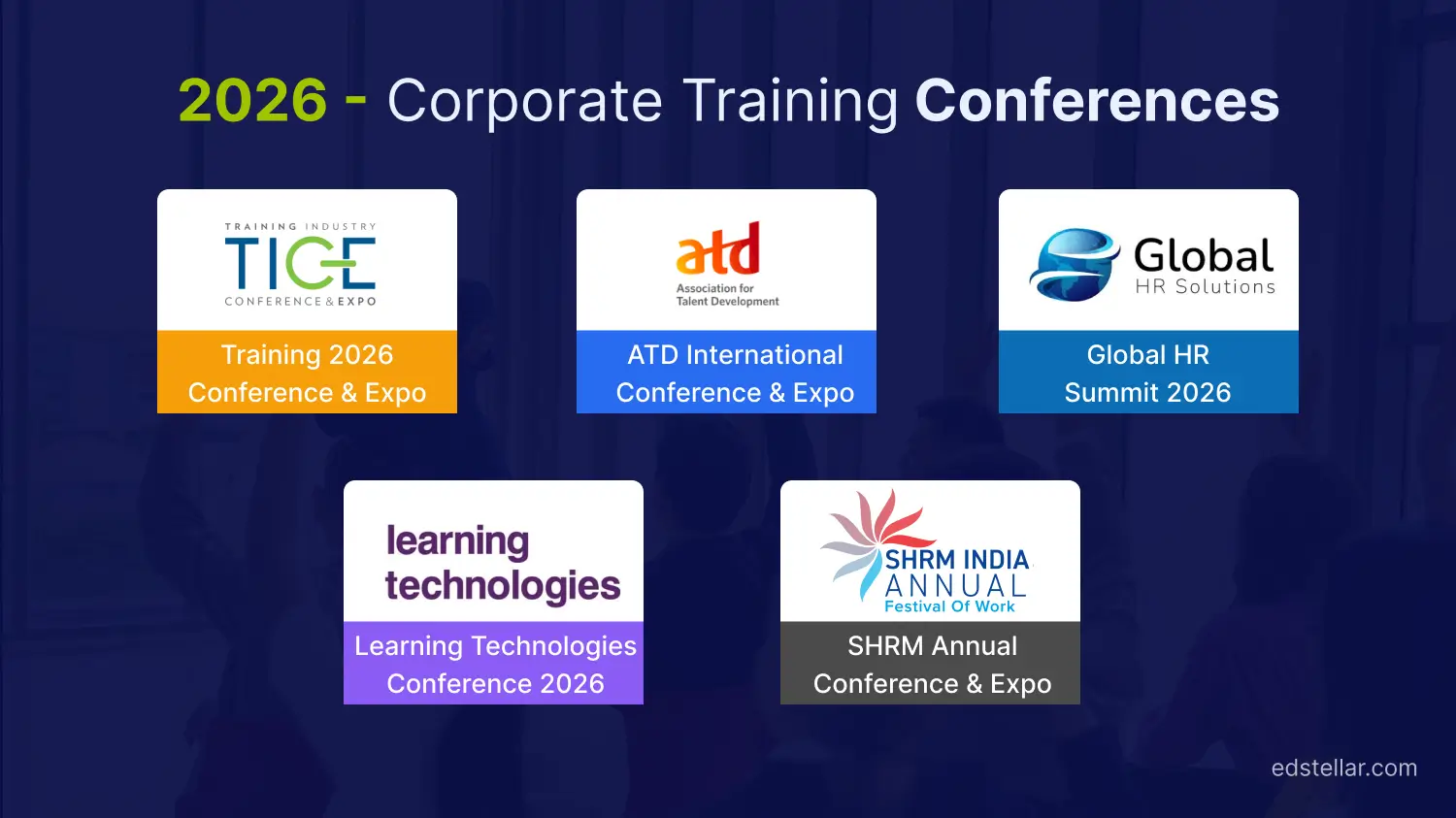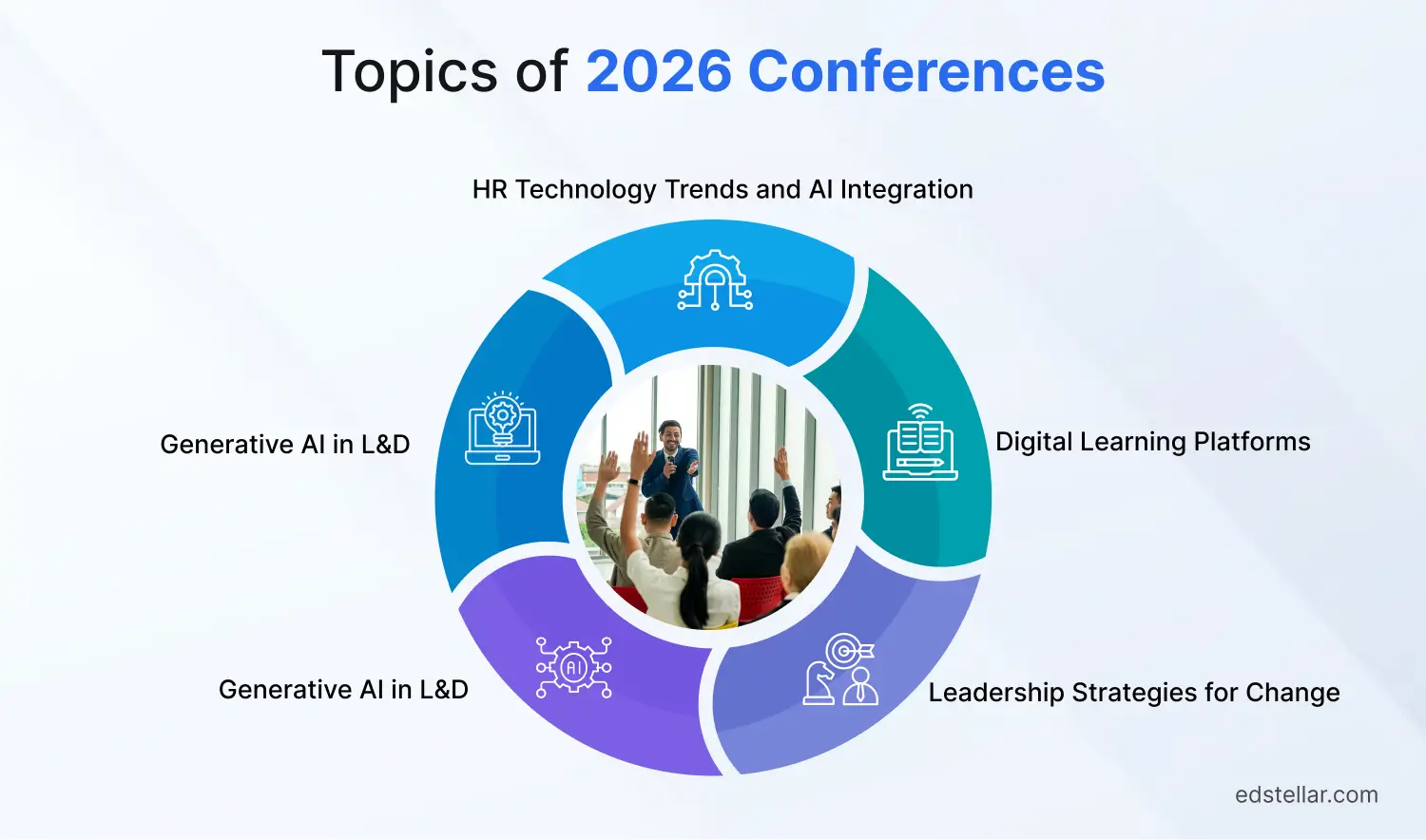
As we navigate through 2026, artificial intelligence, immersive technologies, and data-driven learning strategies are fundamentally reshaping how organizations develop their talent. For learning and development professionals, staying ahead of these changes isn't optional; it's essential.
Corporate training conferences serve as vital convergence points where innovation meets practical application. These gatherings bring together thought leaders, technology providers, and practitioners to share insights, showcase cutting-edge solutions, and forge connections that drive the industry forward. Whether you're a seasoned learning executive or an emerging instructional designer, attending the right conferences can accelerate your professional growth and transform your organization's training initiatives.
This comprehensive guide explores the must-attend corporate training conferences of 2026, the trending topics dominating discussions, and practical strategies to maximize your conference investment.
Top 5 Corporate Training Conferences in 2026
In 2026, the global corporate training and talent development market is projected to surpass $558.18 billion, driven by the need for advanced digital skills, compliance requirements, and rapid technological advancements. With over 70% of organizations reporting accelerated investments in digital learning solutions and 65% of L&D leaders prioritizing AI integration and data-driven upskilling, staying connected with leading industry events has become essential for driving workforce performance and business growth.

1. Training 2026 Conference & Expo
Dates: February 23-25, 2026
Location: Orlando, Florida
Website: trainingconference.com
The 49th Annual Training Conference & Expo, organized by Training magazine, is recognized as the premier training industry conference, focusing on corporate training and development, e-learning, and Instructional design. This three-day event has established itself as a cornerstone gathering for training professionals seeking practical, actionable insights.
Why Attend Training 2026 Conference & Expo?
- Comprehensive exhibition floor featuring the latest training technologies and platforms
- Hands-on workshops and train-the-trainer sessions led by industry experts
- Focus on practical implementation strategies rather than purely theoretical concepts
- Networking opportunities with corporate training directors and CLOs
- Access to case studies from Fortune 500 companies demonstrating real-world applications
Training 2026 Conference & Expo Ideal For: Instructional designers, training managers, e-learning specialists, and corporate educators looking for tactical solutions to immediate training challenges.
2. ATD International Conference & Expo
Dates: May 17-20, 2026
Location: Los Angeles Convention Center, California
Website: atdconference.td.org
The Association for Talent Development International Conference & Exposition, scheduled for May 17-20, 2026, in Los Angeles, represents the world's largest and most comprehensive gathering for talent development professionals. With thousands of attendees from over 80 countries, this four-day event combines strategic thinking with tactical execution.
Why Attend ATD International Conference & Expo?
- Over 300 educational sessions covering every aspect of talent development
- Exposition hall featuring 400+ solution providers and technology vendors
- Pre-conference workshops for deep-dive learning experiences
- International perspective with global best practices and case studies
- Extensive networking events, including chapter meetings and special interest groups
- Research presentations from ATD's research team on industry trends and benchmarks
ATD International Conference & Expo Ideal For: Chief Learning Officers, talent development directors, HR leaders, and learning strategists seeking comprehensive exposure to global best practices and emerging trends.
3. Global HR Summit 2026
Dates: Various (typically held quarterly in different global locations)
Location: Multiple international venues
Website: https://globalhrsummit.org/termsEn
The Global HR Summit series brings together HR and learning leaders from around the world to address the intersection of human resources and learning development. These summits focus on strategic workforce development, organizational culture, and the role of learning in driving business outcomes.
Why Attend Global HR Summit 2026?
- Strategic focus on aligning learning initiatives with business objectives
- Executive-level presentations from CHROs and CLOs of major corporations
- Deep dives into employee experience and engagement strategies
- Focus on measuring learning ROI and business impact
- Regional variations allow for culturally relevant discussions and solutions
Global HR Summit 2026 Ideal For: Senior HR leaders, Chief Learning Officers, organizational development consultants, and executives responsible for workforce transformation initiatives.
4. Learning Technologies Conference 2026
Dates: Typically held in February-March and September (UK and US editions)
Location: London, UK, and Las Vegas, US
Website: https://www.learningtechnologies.co.uk/welcome/conference
The Learning Technologies Conference has established itself as Europe's premier learning and development event, with a growing presence in the US. The conference emphasizes technology-enabled learning solutions, from learning management systems to emerging AI and VR applications.
Why Attend Global HR Summit 2026?
- Heavy emphasis on learning technology platforms and digital transformation
- Exhibition featuring cutting-edge learning technology providers
- Specialized tracks on AI, analytics, and learning experience platforms
- Focus on the practical implementation of learning technologies
- Mix of strategic vision and hands-on demonstrations
- Free conference pass options for qualifying professionals
Global HR Summit 2026 Ideal For: Learning technology managers, digital learning specialists, LMS administrators, and organizations in the midst of digital transformation initiatives.
5. SHRM Annual Conference & Expo
Dates: Typically held in June
Location: Rotates among major US cities
Website: https://annual.shrm.org/
While primarily focused on human resources, the Society for Human Resource Management's annual conference dedicates significant programming to learning and development, talent management, and workforce development. With over 20,000 attendees, it represents one of the largest HR and talent development gatherings globally.
Why Attend SHRM Annual Conference & Expo?
- Comprehensive coverage of legal and compliance aspects of training
- Focus on integrating learning with broader HR and talent strategies
- Executive keynotes from business leaders and thought leaders
- Extensive SHRM certification preparation opportunities
- Networking with HR professionals who influence learning budgets and strategies
SHRM Annual Conference & Expo Ideal For: HR professionals with learning responsibilities, compliance officers, talent management specialists, and those seeking to understand the HR context of corporate training.
Trending Topics of 2026 Conferences
The topics below are discussed in the conferences mentioned above, respectively. In 2026, the corporate training landscape is being revolutionized by the mainstream adoption of AI, extended reality, and next-generation HR technologies. Each conference focuses on areas such as AI-driven learning, digital transformation, and strategic leadership, fueling rapid content creation, personalized development, and immersive experiences. Organizations are embracing these trends to create agile, data-driven, and employee-centric environments, aligning leadership and learning directly with business priorities and future workforce needs.

1. Emerging Training Technologies (AI, VR, Analytics)
2026 represents a pivotal year as extended reality transitions into mainstream business adoption, with AI integration, hyper-realistic experiences, and enhanced mixed reality capabilities shaping how organizations approach learning and work.
List of topics discussed under Emerging Training Technologies:
- Adaptive learning systems that personalize content delivery based on learner performance and preferences
- AI-powered content creation tools that reduce development time by 70-80%
- Intelligent tutoring systems provide real-time feedback and coaching
- Predictive analytics identifies skill gaps before they impact performance
- Natural language processing enabling conversational learning experiences
- Safety training in high-risk environments (manufacturing, construction, healthcare)
- Soft skills development through realistic scenario-based learning
- Technical skills training allowing practice without equipment costs
- Onboarding experiences creating emotional connections to company culture
- Remote collaboration training preparing distributed teams
- Predictive models forecasting training effectiveness and transfer
- Real-time dashboards tracking engagement and completion metrics
- Learning path optimization using machine learning algorithms
- Skills taxonomy mapping linking training to business outcomes
- Continuous feedback loops enabling agile course corrections
2. Generative AI in Learning and Development
Generative AI represents the most disruptive force in corporate training since the advent of e-learning. The Artificial Intelligence in Corporate Training Market is projected to demonstrate explosive growth, expanding from $1.5 billion in 2024 to $10.4 billion by 2033, representing a compound annual growth rate of 25%.
List of topics discussed under generative AI in L&D:
- Automated course creation from existing documentation and subject matter expert interviews
- Dynamic scenario generation for branching simulations
- Personalized assessment question banks
- Multi-language translation and localization at scale
- Video script generation and storyboarding assistance
- Individual learning paths adapt in real-time to learner responses
- Content difficulty adjustment based on demonstrated competency
- Recommendation engines suggesting relevant learning resources
- Personalized reinforcement schedules optimizing retention
- Custom remediation content addressing individual knowledge gaps
- Reduction in content development time from weeks to days
- Automated course updates when policies or procedures change
- Intelligent content curation from vast internal and external sources
- Rapid prototyping enables faster stakeholder feedback cycles
- Scalable one-on-one coaching through AI assistants
- Bias detection and mitigation in AI-generated content
- Transparency about AI involvement in learning experiences
- Data privacy and security considerations
- Human oversight requirements for AI-generated assessments
- Appropriate use cases versus situations requiring human expertise
3. Leadership Strategies for Change
As organizations navigate post-pandemic realities, economic uncertainty, and technological disruption, leadership development has taken center stage. Conference programming addresses:
List of topics discussed under leadership strategies for change:
- Leading through continuous transformation rather than episodic change initiatives
- Building organizational resilience and adaptability
- Communicating vision during periods of uncertainty
- Managing resistance while maintaining psychological safety
- Balancing stability with innovation
- Creating belonging across diverse and distributed teams
- Addressing unconscious bias in decision-making
- Leading with cultural intelligence in global organizations
- Supporting neurodiversity and different working styles
- Translating diversity commitments into leadership behaviors
- Positioning L&D as a strategic business function rather than a service provider
- Speaking the language of business outcomes and financial impact
- Building relationships with C-suite and business unit leaders
- Aligning learning strategy with organizational strategy
- Demonstrating learning's contribution to competitive advantage
- Action learning projects addressing real business challenges
- Peer coaching and learning circles
- Microlearning approaches for busy leaders
- Virtual reality leadership simulations
- Reverse mentoring and cross-generational learning
4. Digital Learning Platforms & Transformation
Digital transformation of learning functions continues to accelerate, with organizations reimagining their entire learning ecosystems. Key discussion areas include:
List of topics discussed under digital learning platforms & transformation:
- Moving beyond traditional LMS to consumer-grade learning experiences
- AI-powered content curation and recommendations
- Integration of user-generated content and social learning
- Skills-based architecture linking learning to career development
- Mobile-first design for learning in the flow of work
- Embedded learning experiences within productivity tools
- Just-in-time microlearning moments
- Performance support integrated with daily workflows
- Reducing time away from productive work
- Measuring impact on actual performance rather than course completion
- Creating seamless experiences across multiple platforms
- Single sign-on and unified learner records
- API strategies enabling best-of-breed solutions
- Data integration for comprehensive analytics
- Balancing standardization with flexibility
- Shift from course-centric to resource-centric learning
- Curation strategies balancing internal and external content
- Video-first content strategies
- User-generated content governance and quality assurance
- Content lifecycle management and continuous improvement
5. HR Technology Trends and AI Integration
The convergence of HR technology and learning technology creates new possibilities for integrated talent management. Conferences are exploring:
List of topics discussed under HR technology trends and AI integration:
- Comprehensive skills taxonomies powering talent decisions
- Skills inference from multiple data sources
- Internal talent marketplaces match skills to opportunities
- Career pathing based on skill development
- Skills-based hiring and promotion decisions
- Predictive analytics identifying high-potential employees
- Flight risk models enabling proactive retention strategies
- Succession planning powered by skills data
- Workforce planning scenarios modeling future capability needs
- Competitive intelligence on external talent markets
- Personalized employee journeys from hire to retirement
- Integration of learning, performance, and career development
- Employee sentiment analysis and action
- Recognition and rewards tied to skill development
- Wellbeing integration acknowledging whole-person needs
- Automated compliance training assignment and tracking
- Risk-based approach to training prioritization
- Audit trails and documentation automation
- Integration of learning data with risk management systems
- Continuous monitoring versus annual certification approaches
Benefits of Attending Corporate Training Conferences
The investment in conference attendance, both financially and in terms of time, yields returns that extend far beyond the event itself. Here's why progressive organizations prioritize conference participation:
- Professional Development and Skill Enhancement: Conferences provide concentrated learning opportunities that would take months to acquire through independent study. Attendees gain exposure to methodologies, frameworks, and techniques that can be immediately applied. The combination of keynotes, breakout sessions, workshops, and expo floor demonstrations creates a comprehensive professional development experience. Many professionals report that a single conference session has transformed their approach to a persistent challenge.
- Networking and Community Building: The relationships forged at conferences often prove more valuable than the formal programming. Conversations with peers facing similar challenges provide practical insights and emotional support. Many attendees leave with a network of trusted advisors they can contact for guidance. The informal learning that occurs in hallway conversations, during meals, and at evening events often rivals that of the formal sessions. These relationships frequently evolve into ongoing professional communities that provide support throughout the year.
- Exposure to Innovative Solutions: Conference exhibitions provide efficient exposure to the latest technologies and service providers. Rather than endless vendor meetings throughout the year, conferences allow side-by-side comparisons and live demonstrations. Many organizations utilize conferences as part of their technology evaluation process, creating shortlists of solutions to explore in more detail. The concentration of providers also enables negotiation of favorable pricing and terms. Early exposure to emerging technologies provides a competitive advantage in implementation.
- Benchmarking and Best Practices: Case study presentations reveal how leading organizations are addressing common challenges. Understanding what works and what doesn't in similar contexts accelerates decision-making and reduces risk. Benchmarking data presented at conferences enables organizations to assess their maturity and identify areas for improvement. Access to research findings and industry trends enables evidence-based decision-making. This outside-in perspective often catalyzes innovation that internal teams struggle to generate.
- Inspiration and Motivation: The energy of conferences reinvigorates professionals who may feel isolated in their daily work. Keynote speakers inspire and challenge assumptions. Seeing the collective progress of the profession renews commitment to continuous improvement. Many attendees return with renewed enthusiasm and fresh ideas that energize their entire team. The validation that comes from connecting with others pursuing similar goals combats burnout and sustains long-term career engagement.
- Strategic Perspective: Stepping away from daily operations creates space for strategic thinking and reflection. Exposure to broader industry trends helps connect daily tactical work to larger strategic objectives. Conference attendance often prompts reflection on career direction and organizational strategy. The combination of inspiration, information, and introspection often yields significant strategic insights and informed decisions.
- Credibility and Career Advancement: Regular conference attendance signals commitment to professional growth and industry engagement. The knowledge and connections gained enhance career prospects both within and outside current organizations. Presenting at conferences establishes thought leadership and visibility. Many professionals report that conference connections have led to career opportunities. Organizations also benefit from the increased credibility that comes from having staff actively engaged in professional communities.
- Efficient Learning: Conferences compress learning that would otherwise require months of research, reading, and trial-and-error. The curated nature of programming ensures exposure to vetted, high-quality content. Multiple learning modalities, visual, auditory, and kinesthetic, ensure that different learning preferences are accommodated. The intensity of the experience also enhances retention compared to spread-out learning activities.
Post-Conference Action Plan
The true value of conference attendance is realized through deliberate follow-up actions after the conference. Too often, the insights and inspiration fade as daily responsibilities reassert themselves. Maximize your investment with this structured approach:
Immediate Actions (Within 48 Hours):
Within the first two days after the conference, set aside focused time to review and organize all notes and resources. Group your insights by main themes instead of reviewing each session individually. This thematic approach helps you identify patterns and pinpoint the three to five most valuable takeaways that can impact your work. Record immediate action items, connections between ideas, and any resources promised during networking to ensure you follow up while everything is still fresh.
Next, reach out proactively to key contacts from the event with personalized follow-ups. Sharing helpful resources or introductions shows initiative and strengthens your professional relationships. Back at your organization, quickly brief your manager and relevant teams on your most important insights and proposed actions. Sharing your summary internally creates excitement around potential changes and makes sure valuable insights don’t get lost in email archives or forgotten notebooks.
Short-Term Actions (Within 2 Weeks):
Over the next two weeks, transition from insight to action by developing a prioritized implementation plan. Evaluate which conference takeaways offer the greatest impact and are feasible within your team’s current resources, then identify the stakeholders needed for successful rollout. Break larger initiatives into specific projects with measurable goals, and quickly pilot any “quick wins” that can be tested without needing full management approval, such as new techniques tried in a single meeting, or a tool demo with a small group.
Documenting even small results builds momentum and makes it easier to justify further investments. During this phase, create a formal presentation or report that distills the most relevant trends, specific examples, and your recommended next steps for leadership and wider audiences. Leverage conference case studies and data to strengthen your case, and tailor your message to each group, from team members to executives, for buy-in and alignment.
Medium-Term Actions (Within 1-2 Months):
In this next phase, move into practical evaluation and skill enhancement. Schedule product demos with promising solution vendors explored at the conference, involving the right cross-functional team members to participate in testing and vetting. Use clear evaluation criteria aligned with your organization’s strategic priorities, request detailed proposals, and, for significant investments, seek references from companies that have implemented these solutions.
This is also an ideal opportunity to pursue professional development inspired by the conference, enroll in relevant courses or certifications, or join the forums and associations suggested by the speakers. Explore opportunities for deeper thought leadership, such as volunteering to speak at industry events or contributing articles to trade publications. Concurrently, integrate your new insights into ongoing strategic planning, updating learning roadmaps, identifying new skill needs, and pitching revised budgets or resourcing requests as necessary.
Long-Term Actions (Ongoing):
As new initiatives take root, continually track outcomes and measure the ROI of changes inspired by your conference experience. Document successes and lessons learned, and actively share these stories with both leadership and your peers to reinforce the value of professional development and continuous learning. Sustain professional relationships fostered at the conference, check in with contacts, contribute to online communities, and keep the dialogue alive by exchanging insights and offering support.
Institutionalize conference learnings by building a central repository for insights and resources, and encourage a culture of knowledge sharing within your team. Rotate conference attendance to spread learning opportunities and fresh perspectives throughout your organization, fostering a culture of continuous learning and growth. Over time, apply new skills to expand your responsibilities and champion best practices, positioning yourself as a thought leader and mentor. This proactive approach will help both you and your organization remain adaptable, innovative, and connected to the broader industry community.
Conclusion
Corporate training conferences represent far more than simply keeping up with industry trends; they're strategic investments in organizational capability and individual growth. As we progress through 2026, the pace of change in learning and development shows no signs of slowing. The decisive shift is clear: training is no longer about completing courses, but about creating personalized, engaging, and future-ready learning ecosystems.
As you plan your 2026 conference calendar, consider not just which events align with your immediate needs, but which will position you and your organization for success in an increasingly complex and technology-enabled learning landscape. The future of corporate training is being shaped at these gatherings. Your participation ensures you're not just observing that future, but actively creating it.
To maximize these benefits, complement your conference experience with Edstellar’s cutting-edge corporate training courses designed to deliver impactful skill development, practical application, and business-aligned outcomes for modern organizations. The question isn't whether to attend conferences in 2026; it's which ones will best serve your professional growth and organizational objectives. Choose wisely, engage fully, and take action deliberately. The investment will pay dividends for years to come.
Explore High-impact instructor-led training for your teams.
#On-site #Virtual #GroupTraining #Customized

Bridge the Gap Between Learning & Performance
Turn Your Training Programs Into Revenue Drivers.
Schedule a ConsultationEdstellar Training Catalog
Explore 2000+ industry ready instructor-led training programs.

Coaching that Unlocks Potential
Create dynamic leaders and cohesive teams. Learn more now!


Want to evaluate your team’s skill gaps?
Do a quick Skill gap analysis with Edstellar’s Free Skill Matrix tool

Transform Your L&D Strategy Today
Unlock premium resources, tools, and frameworks designed for HR and learning professionals. Our L&D Hub gives you everything needed to elevate your organization's training approach.
Access L&D Hub Resources.svg)
.svg)



.svg)
.svg)
.svg)
.webp)
.svg)
.svg)
.svg)
.svg)

